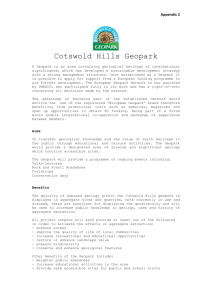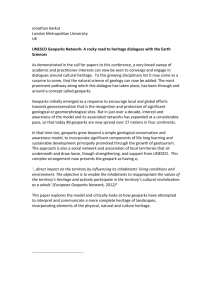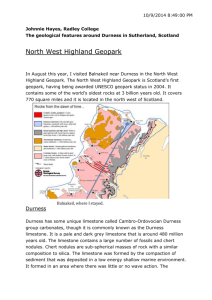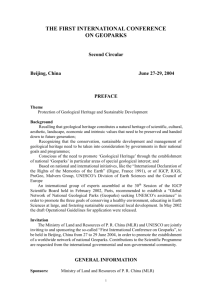Labreport HHohmeister
advertisement
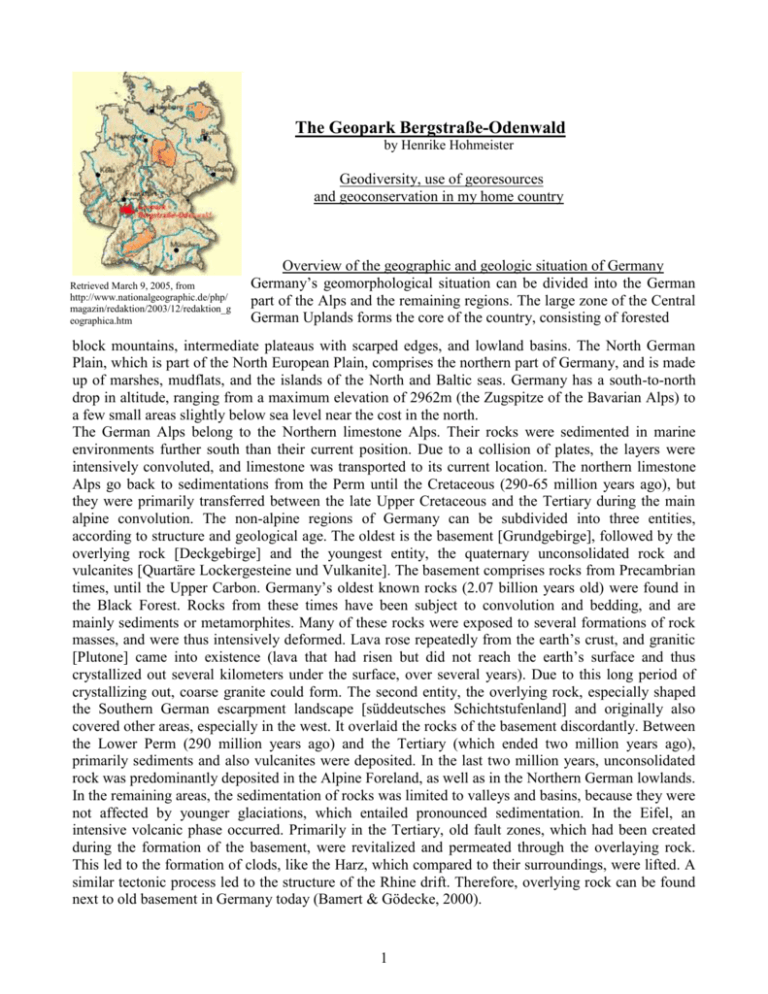
The Geopark Bergstraße-Odenwald by Henrike Hohmeister Geodiversity, use of georesources and geoconservation in my home country Retrieved March 9, 2005, from http://www.nationalgeographic.de/php/ magazin/redaktion/2003/12/redaktion_g eographica.htm Overview of the geographic and geologic situation of Germany Germany’s geomorphological situation can be divided into the German part of the Alps and the remaining regions. The large zone of the Central German Uplands forms the core of the country, consisting of forested block mountains, intermediate plateaus with scarped edges, and lowland basins. The North German Plain, which is part of the North European Plain, comprises the northern part of Germany, and is made up of marshes, mudflats, and the islands of the North and Baltic seas. Germany has a south-to-north drop in altitude, ranging from a maximum elevation of 2962m (the Zugspitze of the Bavarian Alps) to a few small areas slightly below sea level near the cost in the north. The German Alps belong to the Northern limestone Alps. Their rocks were sedimented in marine environments further south than their current position. Due to a collision of plates, the layers were intensively convoluted, and limestone was transported to its current location. The northern limestone Alps go back to sedimentations from the Perm until the Cretaceous (290-65 million years ago), but they were primarily transferred between the late Upper Cretaceous and the Tertiary during the main alpine convolution. The non-alpine regions of Germany can be subdivided into three entities, according to structure and geological age. The oldest is the basement [Grundgebirge], followed by the overlying rock [Deckgebirge] and the youngest entity, the quaternary unconsolidated rock and vulcanites [Quartäre Lockergesteine und Vulkanite]. The basement comprises rocks from Precambrian times, until the Upper Carbon. Germany’s oldest known rocks (2.07 billion years old) were found in the Black Forest. Rocks from these times have been subject to convolution and bedding, and are mainly sediments or metamorphites. Many of these rocks were exposed to several formations of rock masses, and were thus intensively deformed. Lava rose repeatedly from the earth’s crust, and granitic [Plutone] came into existence (lava that had risen but did not reach the earth’s surface and thus crystallized out several kilometers under the surface, over several years). Due to this long period of crystallizing out, coarse granite could form. The second entity, the overlying rock, especially shaped the Southern German escarpment landscape [süddeutsches Schichtstufenland] and originally also covered other areas, especially in the west. It overlaid the rocks of the basement discordantly. Between the Lower Perm (290 million years ago) and the Tertiary (which ended two million years ago), primarily sediments and also vulcanites were deposited. In the last two million years, unconsolidated rock was predominantly deposited in the Alpine Foreland, as well as in the Northern German lowlands. In the remaining areas, the sedimentation of rocks was limited to valleys and basins, because they were not affected by younger glaciations, which entailed pronounced sedimentation. In the Eifel, an intensive volcanic phase occurred. Primarily in the Tertiary, old fault zones, which had been created during the formation of the basement, were revitalized and permeated through the overlaying rock. This led to the formation of clods, like the Harz, which compared to their surroundings, were lifted. A similar tectonic process led to the structure of the Rhine drift. Therefore, overlying rock can be found next to old basement in Germany today (Bamert & Gödecke, 2000). 1 The Geopark Bergstraße-Odenwald 2002 was proclaimed “The Year of Geosciences“ in Germany, in which four national Geoparks were established. The Geopark Bergstraße-Odenwald, situated within the “Naturpark Bergstraße-Odenwald”, was one of them. Since 2002, it is also a member of the European Geopark network. Moreover, since 2004, it belongs to the global UNESCO network of Geoparks. It is located in the southwest of the state Hesse and its territory takes up approximately 2300 km² between the Rhine valley in the West and the Main valley in the East. The Geopark territory comprises more than 500 million years of earth history, which is indicated in the motto of the Geopark: “Granite and Sandstone – Continents on the Move.” The Geopark „Bergstraße-Odenwald“ Retrieved March 11, 2005, from http://www.geonaturpark.net/daten/gebiet.shtml?navid=5. Environmental problems with respect to geological sites Before the establishment of Geoparks, little public attention was directed to the conservation and protection of earthy history in Germany. Urbanization, the regulation of rivers and creeks, road construction, the creation of waste disposal sites or agritechnical measures were often carried out without provision for the importance of geological sites, which due to these undertakings, were lost forever (Steininger, 2001). Geoparks were launched to sustain the protection of the geological heritage, provide earth science education, and foster sustainable economic development. The Geologic Situation of the Geopark Bergstraße-Odenwald The area of the Geopark Bergstraße-Odenwald shows several significant geological features, and can be divided into three parts, which differ considerably with regard to age, formation, and rock composition. The Upper Rhine drift in the West forms the Rhenish lowlands. It originated from the formation of the Alps approximately 50 million years ago, as part of a fracture zone that runs from north to south. The drift is filled with rubble of the surrounding rock masses, reaching a sediment thickness of 4000 m. The landscape is marked by glacial relicts (dunes), as well as post-glacial sediments from Rhine and Neckar. (Retrieved March 9, 2005, from http://www.geo-naturpark.net/geologie/geologie-geopark.shtml.) 2 Towards the East arises the towering crystalline Odenwald, which geologically is the oldest part of the Geopark. Its oldest rocks, metamorphic slates, are presumably over 500 million years old, and were altered several times within the course of earth history. However, the main base of the crystalline Odenwald constitute crystalline plutonic rocks of different chemical composition, which evolved approximately 360-320 million years ago and which also make up the Odenwald’s highest elevations, the Neunkirchner Höhe (605m), and the Melibokus (517m). 360-320 million years ago, two supercontinents collided, the variszic rock masses evolved, and rock-melts [Gesteinsschmelzen] were formed, which rose in the earth’s crust and formed a so-called “magmatic arch.“ This “hot interface” of colliding continents forms the rock-subsoil of the crystalline Odenwald. It consists mainly of granites, granodiorites, diorites, and gabbros. Schematic Overview of the Geopark-territory. Retrieved March 11, 2005, from http://www.geo-naturpark.net/geologie/geologie-geopark.shtml. Gabbros, as well as peridotites are visible at the Frankenstein-Complex. Further towards the East, a fault zone draws through the Odenwald from north to south. Having originated in the antiquity of earth [Erdaltertum], it became active due to the formation of the Alps approximately 35 million years ago, in 3 the Tertiary. Basaltic melted rock from the earth’s mantle rose to the surface, and the relicts of this phase still significantly rise above the landscape – the Roßberg and the Otzberg are crater-fillings [Kraterfüllungen] of Tertian volcanoes, which withstood sedimentation. East of the Otzberg-fault zone is a smaller part of the crystalline Odenwald, the so-called “Böllsteiner Odenwald”, composed of crystalline and metamorphic rocks. In the East, the crystalline Odenwald is covered by remaining parts of the overlying rock: The large-area forests, plateaus, as well as waterrich, deeply incised valleys are typical of the variegated sandstone-Odenwald. It consists of sand and slit, which was sedimented approximately 250 million years ago, in a river- and lake-landscape. Later, in the younger medieval times of earth [Erdmittelalter] the Odenwald was flooded due to a worldwide sea-level rise, and covered by sea-sediments. However, in large areas of the Geopark, these were ablated again. Due to the irruption of the Upper Rhine drift approximately 50 million years ago the Geopark-territory was significantly deformed: The Basaltic Rocks at the Otzberg. Retrieved March 9, 2005, from http://www.geonaturpark.net/geologie/geologie-geopark.shtml. Whereas the western part sank at the limiting fault zones, the large clods at the margins rose and were tipped [verkippt] in eastward direction. There, the erosion opened up the crystalline basement, which is why the area is called the “crystalline Odenwald.“ The variegated sandstone-Odenwald in the East was not as exposed to the seasediments from the medieval times of earth. Thus, it is still conserved in form of the luminous variegated sandstone. The Geopark-area only obtained its current surface configuration relatively late. At the beginning of the glaciations, approximately 2 million years ago, the sea level dropped 100m worldwide and reinforced sedimentation and erosion through rivers and creeks. The landscape of the low mountain range evolved as a result of worldwide tectonic processes as well as extreme fluctuations in climate. Formations like the numerous conglomerations of rocks of the Odenwald (i.e. the “Felsenmeer of Reichenbach) were only exposed within this relatively young geological phase. (The rocks at Reichenbach obtained a particularly round form due to drastic tropical weathering in the Tertiary). Approximately 10.000 years ago, at the beginning of the Holocene, a warm phase set in and a manifold mosaic of soils The Felsenmeer of Reichenbach developed (Weber & Eckhardt, 2003). Retrieved March 9, 2005, from http://www.swr.de/regionen/kurpfalz/ gepark/index1.html. The Use of Georesources: Geotourism, Environmental Education, and Geotope Protection Geotourism is not simply “Geology-tourism”, it is a complex marketing of the region with regard to landscape, with the aim of sustaining the environment, but also marketing and conveying its special features with regard to earth history and landscape (Mattig, 2002). By closely cooperating with local agriculture and craft, regional geoproducts are marketed in the Geopark Bergstraße-Odenwald. As the Geopark is situated within the “Naturpark“, a great amount of infrastructure was already present before the Geopark was launched. 10.000 kilometers of marked hiking (adventure) trails are accessible to tourists. The Geopark also attempts at raising public awareness through intensive marketing, as well as active cooperation with local educational institutions. To provide environmental education, GeoparkRangers guide through the park. The environmental education is mainly aimed at children and 4 teenagers, to make objects “graphic” and understandable for them – as only what is known to future generations can be valued and protected. The motto of the year 2005 is “experiencing landscape” and there are many opportunities to attend informative and entertaining presentations. Centers of information are located at interesting sites with regard to geology and cultural history. Hints at prevailing topics of the regions are given in several “discovery areas” – tourists can discover and inform themselves about minerals, earth history, mining, geomorphology, the cultural landscape and water supply and distribution ( i.e. in the crystalline Odenwald, tourists can put their hands on the collision zone of two primordial continents). Many relicts in the region are evidence of active mining in earlier times – especially iron and manganese were mined in today’s Geopark. View from the variegated sandstone-Odenwald to the crystalline Odenwald. Retrieved Mach 9, 2005, from http://www.geo-naturpark.net/geologie/geologiegeopark.shtml. The “Grube Messel” is a world heritage site, as is the Monastery Lorsch, which bring tourists from different areas of interest to the Geopark. With regard to geotope protection, the Geopark Bergstraße-Odenwald closely cooperates with the local institutions responsible for geological sites. As a member of the section for geotope protection of the Deutsche Geologische Gesellschaft, it takes part in the current national discussion on the questions of geotope protection. The Geopark presents possibilities for scientific research, and it exchanges knowledge and expertise with universities, other geoparks, research institutes and other bodies on the European and international level under the umbrella of UNESCO. Exchange provides the adequate provision for geotope protection when planning and realizing geotouristic measures, following the requirements for Geoparks - “protection by sustainable use.“ Thus, the Geopark Bergstraße-Odenwald succeeds in combining the protection of the geological heritage with environmental education and fostering economic development through geotourism and marketing geoproducts of the region. Sources Bamert, E., & Gödecke, R. (2000). Die Geologie Deutschlands – Ein Überblick. Retrieved March 14, 2005, from http://www.tu-darmstadt.de/fb/geo/min/barnert/geoldeu.htm. Der GeoPark Bergstraße-Odenwald. (n.d.) Retrieved Marh 11, 2005 from http://old.planeterde.de/DasJahr/GeoParks/Bergstrasse_Odenwald. Discover Earth history, nature, man and culture in a fascinating territory – the UNESCO-Geopark Bergstraße-Odenwald. (n.d.) Retrieved March 9, 2005, from http://www.geo-naturpark.net/daten/english.shtml. Establishing National Geoparks in Germany. (2002). Retrieved March 11, 2005, from http://old.planeterde.de/DasJahr/GeoParks/index_en_html. Germany. (2005). Encyclopedia Britannica. Retrieved March 12, 2005, from Encyclopedia Britannica Online, http://search.eb.com/article?tockl=57984. Mattig, U. (2002). Geotourismus als geowissenschaftliche Öffentlichkeitsarbeit. Akad. Geowiss. Hannover, Veröffentl., 21, 47-50. Retrieved March 11, 2005, from http://www.geoakademie.de/PDF/Heft21/Mattig.pdf. Steininger, F. F. (2001). Erlebbare Archive der Erdgeschichte. Retrieved March 11, 2005, from http://www.geo-naturpark.net/daten/geoparkfachaufs%E4tze.shtml. Weber, J., & Eckhardt, C. (2003). Zwischen Granit und Sandstein – Landschaft erleben. Der Naturpark Bergstraße-Odenwald als Europäischer und Nationaler Geopark. In H. Quade (Ed.), Geoforum 2003 Geotope – Geoparks – Geotourismus (pp. 100-106). Hannover: Akademie der Geowissenschaften. Zur Geologie des Geoparks Bergstraße-Odenwald. (n.d.) Retrieved March 11, 2005, from http://www.geo-naturpark.net/geologie/geologie-geopark.shtml. 5
